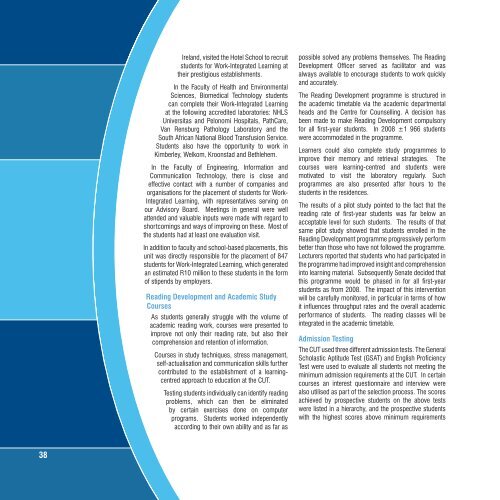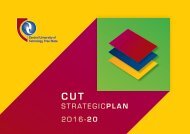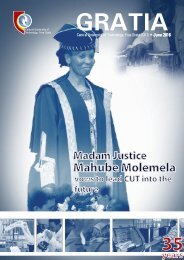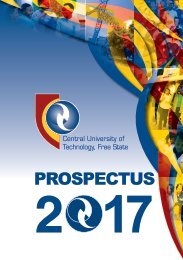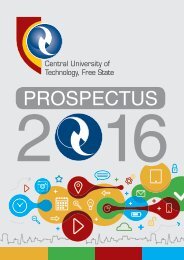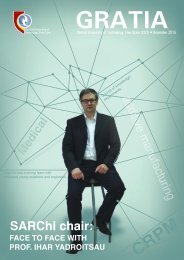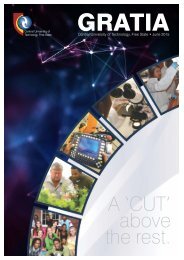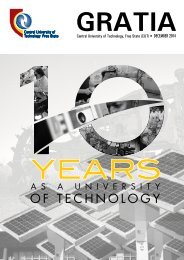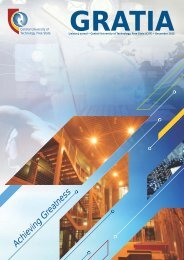CUT Annual Report 2008
The Annual Report is a premier publication that reports on institutional development and successes.
The Annual Report is a premier publication that reports on institutional development and successes.
Create successful ePaper yourself
Turn your PDF publications into a flip-book with our unique Google optimized e-Paper software.
Ireland, visited the Hotel School to recruit<br />
students for Work-Integrated Learning at<br />
their prestigious establishments.<br />
In the Faculty of Health and Environmental<br />
Sciences, Biomedical Technology students<br />
can complete their Work-Integrated Learning<br />
at the following accredited laboratories: NHLS<br />
Universitas and Pelonomi Hospitals, PathCare,<br />
Van Rensburg Pathology Laboratory and the<br />
South African National Blood Transfusion Service.<br />
Students also have the opportunity to work in<br />
Kimberley, Welkom, Kroonstad and Bethlehem.<br />
In the Faculty of Engineering, Information and<br />
Communication Technology, there is close and<br />
effective contact with a number of companies and<br />
organisations for the placement of students for Work-<br />
Integrated Learning, with representatives serving on<br />
our Advisory Board. Meetings in general were well<br />
attended and valuable inputs were made with regard to<br />
shortcomings and ways of improving on these. Most of<br />
the students had at least one evaluation visit.<br />
In addition to faculty and school-based placements, this<br />
unit was directly responsible for the placement of 847<br />
students for Work-Integrated Learning, which generated<br />
an estimated R10 million to these students in the form<br />
of stipends by employers.<br />
Reading Development and Academic Study<br />
Courses<br />
As students generally struggle with the volume of<br />
academic reading work, courses were presented to<br />
improve not only their reading rate, but also their<br />
comprehension and retention of information.<br />
Courses in study techniques, stress management,<br />
self-actualisation and communication skills further<br />
contributed to the establishment of a learningcentred<br />
approach to education at the <strong>CUT</strong>.<br />
Testing students individually can identify reading<br />
problems, which can then be eliminated<br />
by certain exercises done on computer<br />
programs. Students worked independently<br />
according to their own ability and as far as<br />
possible solved any problems themselves. The Reading<br />
Development Officer served as facilitator and was<br />
always available to encourage students to work quickly<br />
and accurately.<br />
The Reading Development programme is structured in<br />
the academic timetable via the academic departmental<br />
heads and the Centre for Counselling. A decision has<br />
been made to make Reading Development compulsory<br />
for all first-year students. In <strong>2008</strong> ±1 966 students<br />
were accommodated in the programme.<br />
Learners could also complete study programmes to<br />
improve their memory and retrieval strategies. The<br />
courses were learning-centred and students were<br />
motivated to visit the laboratory regularly. Such<br />
programmes are also presented after hours to the<br />
students in the residences.<br />
The results of a pilot study pointed to the fact that the<br />
reading rate of first-year students was far below an<br />
acceptable level for such students. The results of that<br />
same pilot study showed that students enrolled in the<br />
Reading Development programme progressively perform<br />
better than those who have not followed the programme.<br />
Lecturers reported that students who had participated in<br />
the programme had improved insight and comprehension<br />
into learning material. Subsequently Senate decided that<br />
this programme would be phased in for all first-year<br />
students as from <strong>2008</strong>. The impact of this intervention<br />
will be carefully monitored, in particular in terms of how<br />
it influences throughput rates and the overall academic<br />
performance of students. The reading classes will be<br />
integrated in the academic timetable.<br />
Admission Testing<br />
The <strong>CUT</strong> used three different admission tests. The General<br />
Scholastic Aptitude Test (GSAT) and English Proficiency<br />
Test were used to evaluate all students not meeting the<br />
minimum admission requirements at the <strong>CUT</strong>. In certain<br />
courses an interest questionnaire and interview were<br />
also utilised as part of the selection process. The scores<br />
achieved by prospective students on the above tests<br />
were listed in a hierarchy, and the prospective students<br />
with the highest scores above minimum requirements<br />
38


